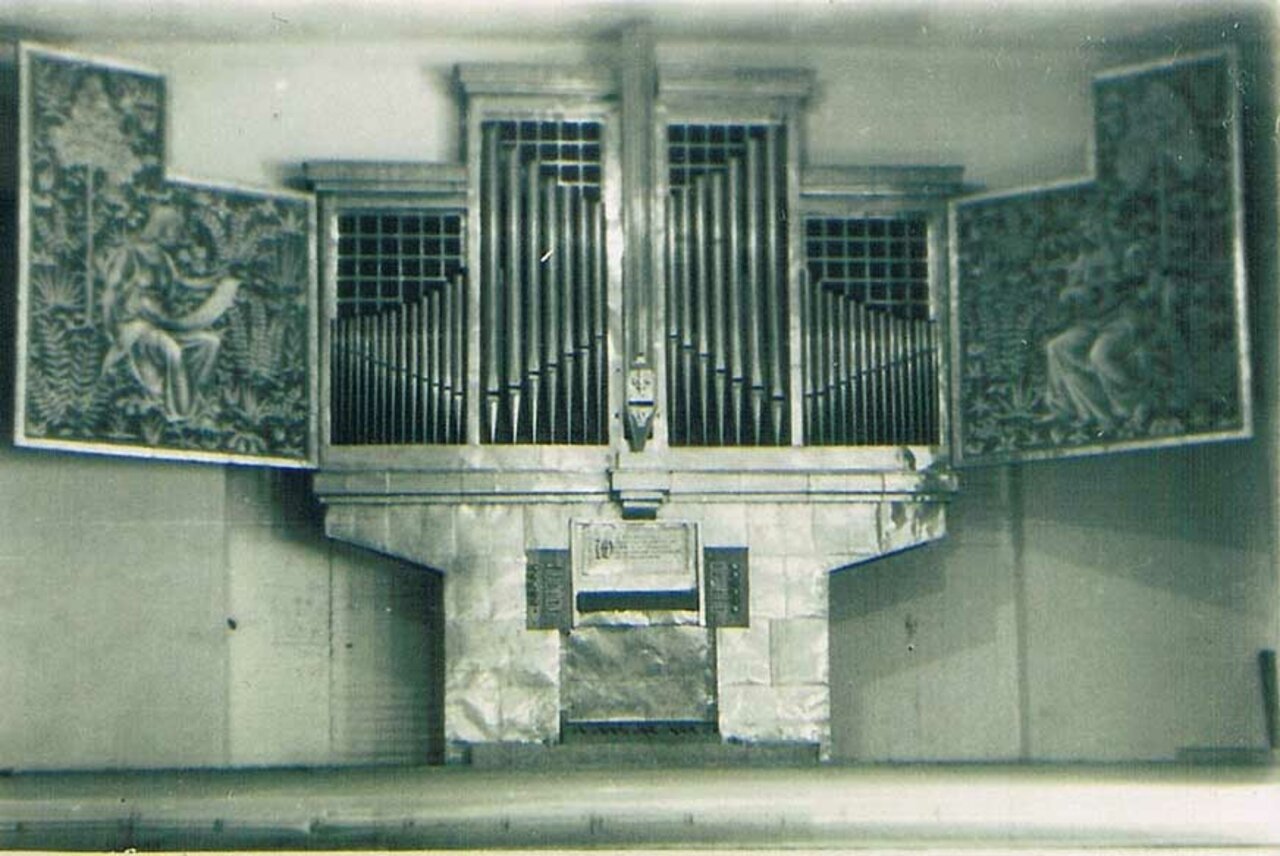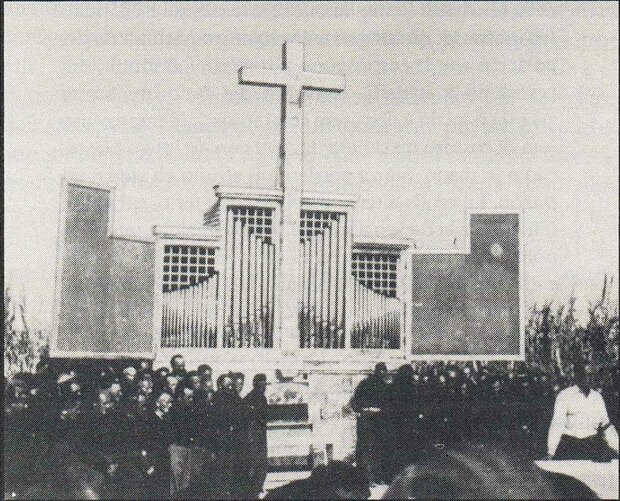In June 1945 a note was pinned on a notice-board on the main square of the prisoner-of-war camp with the following text:
“Looking for fellow organ-builder interested in cultural exchange.“
Eusebius Schäbung, Hole 28, Block 14 between 11th street to Rimini and 6th to San Marino
Two organ-builders are brought together and through the initiative and under the direction of master organ-builder Werner Renkewitz (ex-Sergeant-Major I./274) a great and moving story evolves.
POWs‘ Scrap Organ of Rimini
Old tin-cans and biscuit-tins become organ-pipes. 50 old wooden boxes and grocery crates are fashioned into wind chests and case, steel wire fashioned into abstract art, an old pair of leather shorts, old boot-legs and an old greatcoat into seals for pallets and windchests. Solder is melted out of canisters. A camp chaplain supports the project and finds materials from the outside the camp. Among the prisoners are numerous craftsmen, artists and architects, so that gradually a group of 12 workers is put together. At first the Anglo-American guards watch the activity in the camp carefully and with some suspicion, the German prisoners could be making weapons.
Dedication after just three months
Three months and 3,600 working hours later, on Friday, the 13th September 1945, at 8.15 pm the first notes of the organ are heard and two days later, on Sunday, the 15th September, the organ is ceremoniously dedicated. The instrument stands in the open on the beach in 4-metre high frame, artistically crafted from hand-sawn slats and planks, Principal 8´ in the organ screen, two wing-doors right and left with a big imposing cross in the middle: an art-work from war’s detritus.
The dedication is performed by the Bishop of Rimini. It must have been a great and moving occasion for all. The prisoners, the sentries of the guards, officers and soldiers of all branches of the service, Germans, Americans, English, French, Poles and Italians; erstwhile enemies united in a service of dedication.
Working together they created something unique which would have been considered impossible. The organ plays. An organist composes a special piece for the dedication, a huge 1000 man choir sings And the chaplain delivers moving words: "Let us take the organ as an example! The pipes, small and big, all play together, each gives of his best and small contributions together create a community." The Bishop gives his blessing and thousands sing "Großer Gott, wir loben dich". (Holy God we praise Thy name ) The organ is given the name "JUBILATE".
From then on the organ was played every morning for the morning mass and in the evening at 10.30. A camp inmate relates: "The visual effect of the organ was incomparably beautiful, especially when the moonlight shone on the opened organ-screen. Before a backcloth of the southern stars stood the huge silver cross dominating the centre of the organ."
The sound of the organ alters people and life in the camp. The harmony rubs off on the prisoners and their captors. A peaceful atmosphere evolves.

The little organ becomes a great concert instrument
So that the organ did not have to stand all winter in the open, in autumn 1945 a hall was specially created for it. The POWs refurbished an erstwhile airplane hanger, which they christened the "Deutschlandhalle". It had seating for 4,000 and was the scene of a rich offering of concerts and stage-productions (numerous programmes still exist). For the celebration of Christmas in 1945 the organ was heard for the first time in its new location, augmented in the meantime with new registers as follows:
Manual:
Principal 8´ – Bourdon 8´- Octave 4´- Flute 4´- Quint 3´- Super-octave 2´-
Third 1 3/5´- Mixture 3 rangs 1 1/3´
Pedal:
Sub-bass 16´- Bourdon 8´- Night horn 4´- Trombone 16´
502 pipes
Keyboard: 48 keys
Bellows: hydraulic
For the painting of the organ an English general organised a competition among the POWs. The wing-doors were superbly decorated by artist Peter Recker: two angel figures with lute and fiddle in a flower garden.
The large cross in the middle of the screen is now replaced by the low C pipe in the Principal 8′. In the period thereafter the organ becomes the focus for a whole series of concerts. A camp orchestra is founded, symphony concerts, first performances, camp services; reports say that the organ is being played morning, noon and night. This continues for two years, until 1947. Werner Renkewitz and his POW organ quickly became famous. The English diplomat and ex-Minister for German Affairs and Konrad, Cardinal of Preysing, Bishop of Berlin are among the dignitaries who come to Rimini to hear the organ. The English are so impressed that they want to whisk both the organ and its builder off to England.
When the prison camp was closed, the organ was taken to a church in Rimini, where it was destroyed in a fire. Only a few blackened components are still in existence.
The story continues
The Rimini organ – a true story! A story about the tragic fate of the soldiery, of war and peace, a moving story of humanity for humanity. A small organ becomes a symbol of survival for a whole group of men. The building and the playing of the organ, its music put the men back on their feet, gave them strength. The fascinating and incredible thing about it is, its story and its music still resonates after 75 years. Many survivors of the Rimini-Belaria camp and all those who heard the organ can’t get it out of their heads. It still moves them to tears. The memory of the organ, of the spirit of common purpose in the camp, the will to survive, singing "Großer Gott, wir loben Dich" accompanied by the organ – not something one forgets – that stays with you your whole life.
The above is how today men of over 90 still talk about it. Over the last 75 years many have undertaken the pilgrimage back to Rimini to look for their organ and to remember a great story.
A newspaper report of 1945: "The showpiece of the whole camp town more than just a piece of Robinson Crusoe romance. Is this organ made of ration-cans and old shoe-leather not proof that even the horror and privation of so many years of war are not able to destroy the ancient yearning of mankind for what is beautiful and noble? And those who despair of the human race may find in this new hope to believe in the goodness in man".
The inscription above the manual read:
"Who’er in future days
shall lay his hands upon these keys
– we shall by then be far away-
let him devoutly and with awe
be mindful of a darker time
and of the men who made them play"
A small organ causes big headlines
In the 1960s the story of the prisoners‘ organ quickly became known. There are numerous newspaper reports (including in the popular press) and a radio broadcast by Werner Renkewitz in WDR, in which the Rimini organ is heard playing the little C Major Prelude by J.S. Bach. There are reports that a US General had a copy of the Rimini organ built in America.
How could this be continued today, after over 75 years?
It is our dream to resurrect the Rimini organ as a remembrance, admonition and symbol of peace in Europe.
Can you help? All kinds of support and help for the project would be welcome:
- publicising the Rimini story in your area
- translation and publishing of the above text in your country
- help in the search for sponsors
- direct financial support
For the Initiative "Rimini Organ" Michael Grüber, D-Horb a.N. (Juli 2014)
www.rimini-orgel.de
Michael Grüber, Marktstr. 8, D-72160 Horb am Neckar
Tel. 07451 / 900 79 92 Michael.Grueber@gmx.de
www.ORGANpromotion.org
Translation by Peter Kirk
